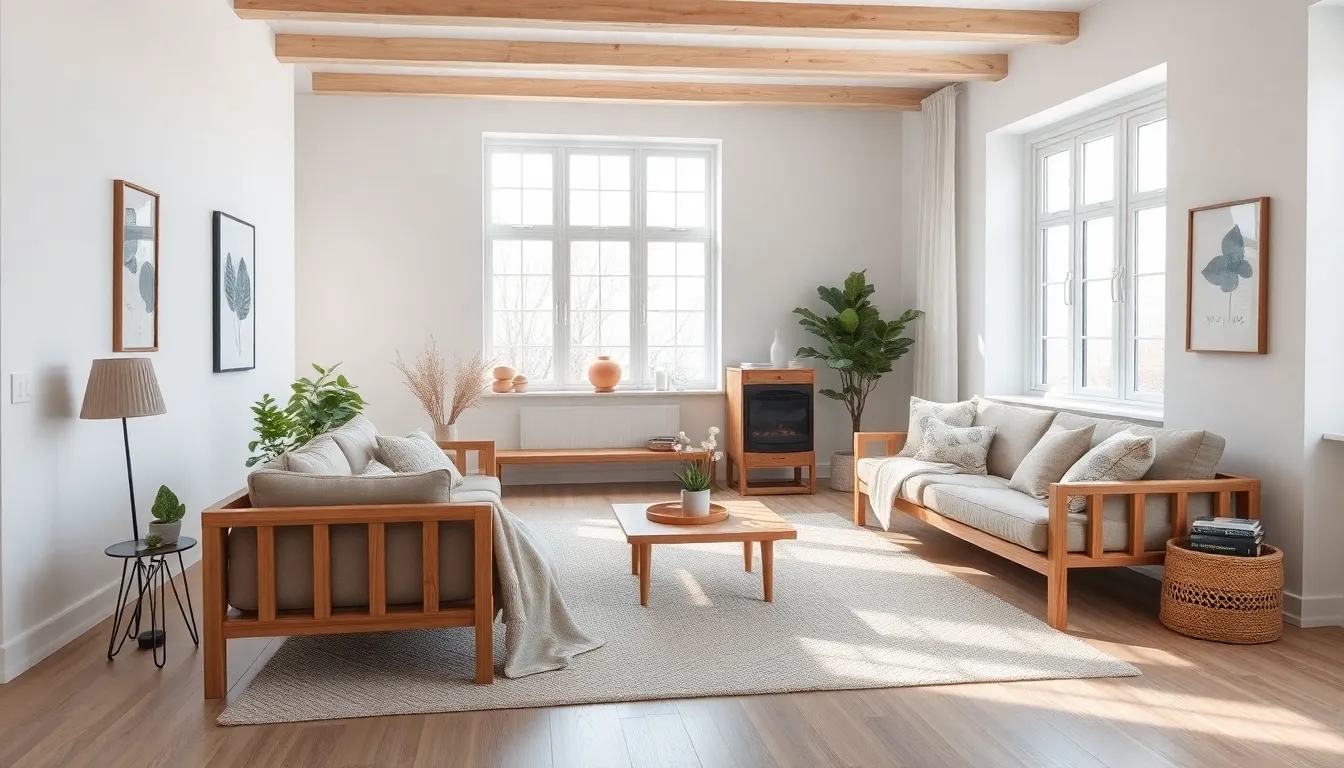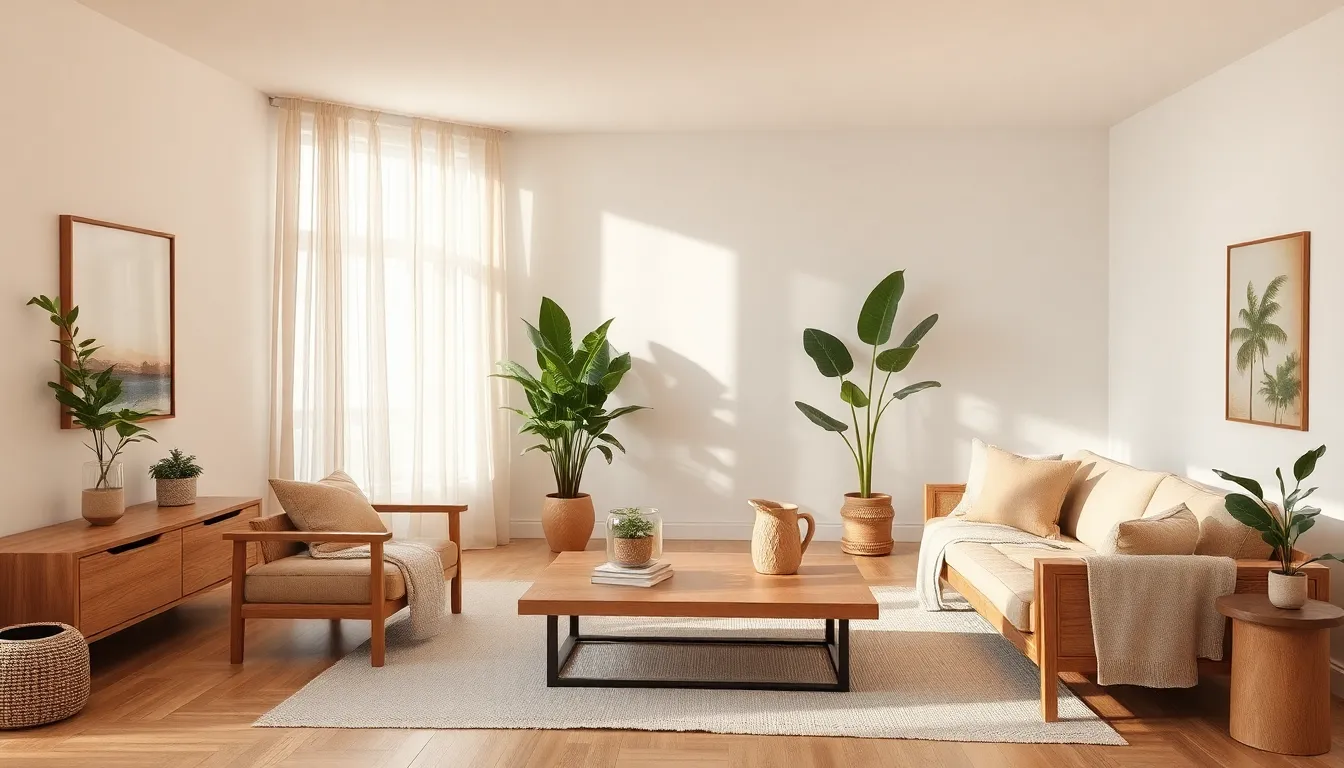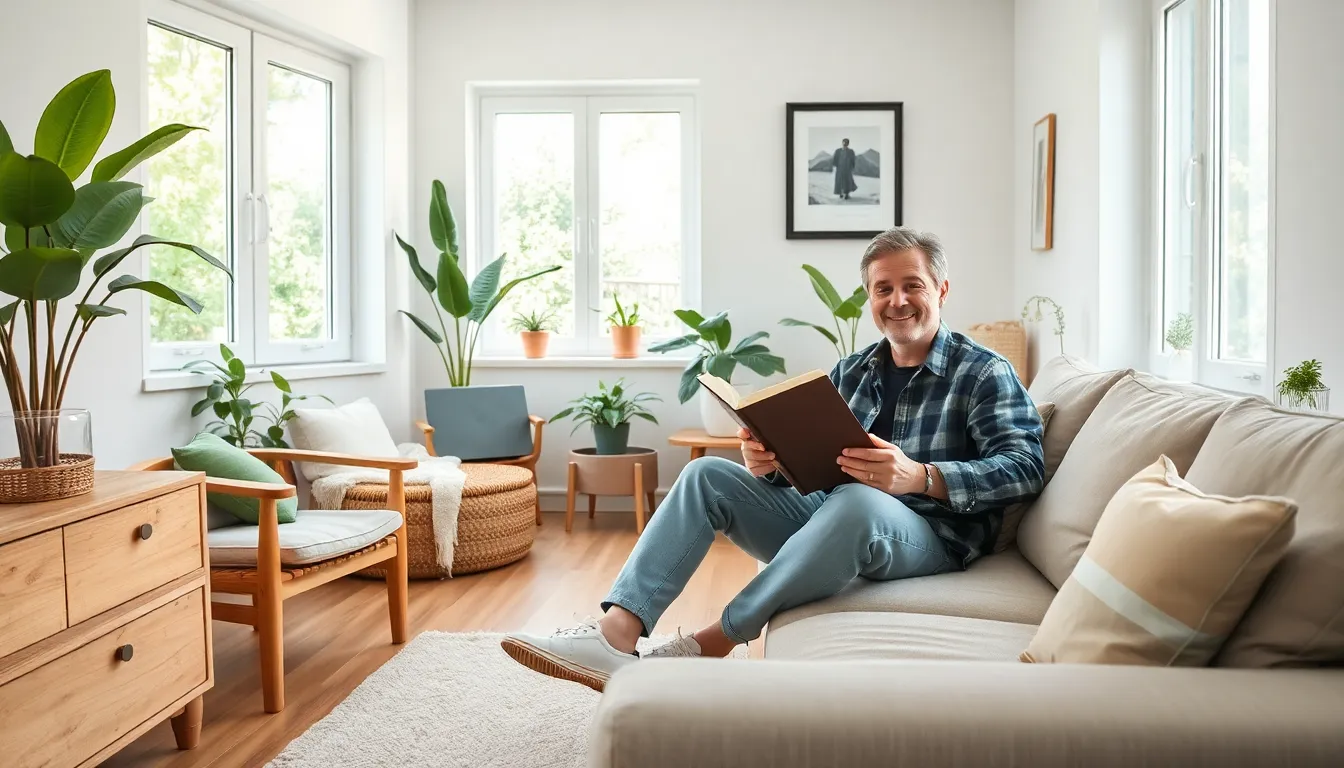In a world overflowing with clutter and chaos, warm minimalism emerges as the stylish superhero we didn’t know we needed. Imagine a home that feels both serene and inviting, where each piece serves a purpose and every corner whispers comfort. It’s not just about less stuff; it’s about creating a space that embraces simplicity while radiating warmth.
Table of Contents
ToggleUnderstanding Warm Minimalism
Warm minimalism merges simplicity with comfort, creating serene and inviting environments. This design approach values purpose in every element, promoting a cozy lifestyle while embracing minimalism.
Definition and Principles
Warm minimalism prioritizes functionality alongside aesthetic appeal. It emphasizes clean lines and uncluttered spaces, allowing comfort and warmth to flow through each room. Natural materials play a crucial role, often including wood, stone, and textiles that evoke a sense of tranquility. The design encourages intentionality, where every piece contributes to the overall atmosphere. Using a muted color palette, warm minimalism fosters a sense of calm by avoiding overwhelming hues.
Key Aesthetics of Warm Minimalism
Textures significantly enhance warmth in warm minimalism. Soft textiles like wool and linen create contrast against sleek surfaces. Earthy tones often dominate the color scheme, with beiges, whites, and soft grays frequently appearing. Lighting also plays a vital role; warm, diffused light adds a cozy ambiance. Decor items generally include fewer but meaningful pieces, ensuring each item resonates with the overall style. Plants frequently contribute to a refreshing touch, integrating natural elements that soften the minimalist theme.
The Origins of Warm Minimalism

Warm minimalism has roots in various historical movements that emphasize simplicity and functionality. This design approach prioritizes comfort while rejecting excess, leading to serene and inviting spaces.
Historical Context
The origins of warm minimalism trace back to several significant art and design movements. The Bauhaus movement in the early 20th century championed minimalistic principles, emphasizing functional design and simplicity. Mid-century modern design further solidified these concepts, introducing organic forms and warm materials. In the 1960s and 1970s, the Swedish aesthetic of lagom advocated balance and moderation, influencing contemporary warm minimalism. Today, a focus on sustainability and intentional living drives the evolution of this design style, as people seek to create environments that reflect both beauty and comfort.
Influential Designers and Movements
Several designers and movements have shaped warm minimalism. Tadao Ando, known for his use of concrete and natural light, creates spaces that blend minimalism with warmth. Designers like Nitori and Muji emphasize functional furnishings with natural materials, aligning with this design philosophy. Additionally, the Japanese concept of wabi-sabi promotes an appreciation for imperfection and the beauty of nature, resonating deeply within warm minimalism. Furthermore, Scandinavian design, with its focus on simplicity and warmth, encourages the integration of cozy elements into minimalist spaces. Each of these influences contributes to a cohesive aesthetic that values purpose and comfort.
Benefits of Warm Minimalism
Warm minimalism offers several compelling benefits that enhance both living environments and psychological well-being. By blending simplicity with warmth, it creates inviting spaces that foster tranquility.
Psychological Effects
Warm minimalism significantly impacts mental health. It promotes a sense of calm by minimizing clutter, which often leads to reduced stress levels. Environments that emphasize natural materials, like wood and stone, cultivate a grounding effect, encouraging relaxation. Soft textures add comfort while muted color palettes contribute to a soothing atmosphere. Studies show that exposure to tailored, minimalistic designs can enhance focus and creativity. Embracing intentional living fosters mindfulness, allowing individuals to become more connected to their surroundings.
Practical Advantages in Living Spaces
Warm minimalism brings practical benefits to everyday life. Simplified spaces are easier to maintain, requiring less time on cleaning and organizing. A focus on functionality ensures that each item serves a purpose, reducing excess possessions. Natural materials improve air quality and energy efficiency, contributing to sustainable lifestyles. Moreover, incorporating plants introduces elements of nature, enhancing well-being. Thoughtful design choices allow for versatility, making each space adaptable to various activities. By prioritizing comfort alongside aesthetics, warm minimalism encourages enjoyable and livable environments.
Implementing Warm Minimalism in Your Home
Creating a warm minimalist home involves thoughtful choices that exude comfort and serenity. Prioritizing natural elements enhances the inviting atmosphere.
Color Palettes and Textures
Earthy tones dominate warm minimalism, fostering a soothing environment. Soft whites, warm grays, and muted greens create a cohesive color palette that promotes tranquility. Incorporating natural textures enriches the space, as wood grains, linen fabrics, and stone surfaces add depth. Varied textiles like woven rugs and knitted throws provide warmth without cluttering the aesthetic. Using a balanced mix ensures the design feels curated and intentional. Warm, diffused lighting amplifies these elements, enhancing the cozy ambiance further.
Furniture and Decor Choices
Furniture choices in warm minimalism focus on functionality and simplicity. Pieces with clean lines, such as low-profile sofas and simple dining tables, create open spaces. Soft, inviting materials, including leather and upholstered fabric, add comfort. When selecting decor, aim for a few meaningful items rather than an abundance of decor pieces. Thoughtful selections like handmade pottery or family photographs resonate with the space’s overall style. Integrating plants not only beautifies the environment but also improves air quality, enhancing the minimalist philosophy.
Warm Minimalism in Different Spaces
Warm minimalism enhances various spaces by emphasizing both simplicity and comfort. Each area maintains a cozy atmosphere while prioritizing functionality and elegance.
Living Room Transformation
A living room embodies warmth with a strategic balance of decor and furniture. Natural materials, like wood and soft textiles, create an inviting feel. Eloquent furniture arrangements promote easy movement, ensuring spaces remain uncluttered. Earthy tones, such as soft whites and muted greens, introduce a sense of tranquility. Personalize the space with a few thoughtfully chosen decor items rather than overwhelming the senses. Integrating plants or natural elements enhances air quality and comfort. Lighting plays a crucial role, with warm, diffused options fostering a relaxed ambiance. Each item invites relaxation, embodying the essence of warm minimalism.
Bedroom Sanctuary
The bedroom serves as a personal retreat through the principles of warm minimalism. Soft textiles and muted color palettes create serenity and foster restful sleep. Organized spaces prioritize functionality, ensuring every piece serves a purpose. Incorporating natural elements, such as plants, enhances tranquility and enriches air quality. Bedding materials, like linen or cotton, provide comfort while maintaining an aesthetic appeal. Selecting calming artwork or minimalistic decor allows for self-expression without cluttering the environment. Dimmed lighting, complemented by warm hues, promotes a soothing atmosphere. Together, these elements create an inviting sanctuary that reflects modern minimalistic elegance.
Conclusion
Warm minimalism offers a refreshing approach to modern design by blending simplicity with comfort. This aesthetic prioritizes intentional living and creates serene spaces that enhance overall well-being. By focusing on natural materials and earthy tones, it fosters an inviting atmosphere that promotes relaxation and mindfulness.
As individuals seek balance in their lives, warm minimalism provides a pathway to achieve that harmony within their homes. Its emphasis on functionality and thoughtful decor allows for personal expression while maintaining a clutter-free environment. With its roots in historical design movements and a contemporary focus on sustainability, warm minimalism continues to inspire those looking to create tranquil and purposeful spaces.





